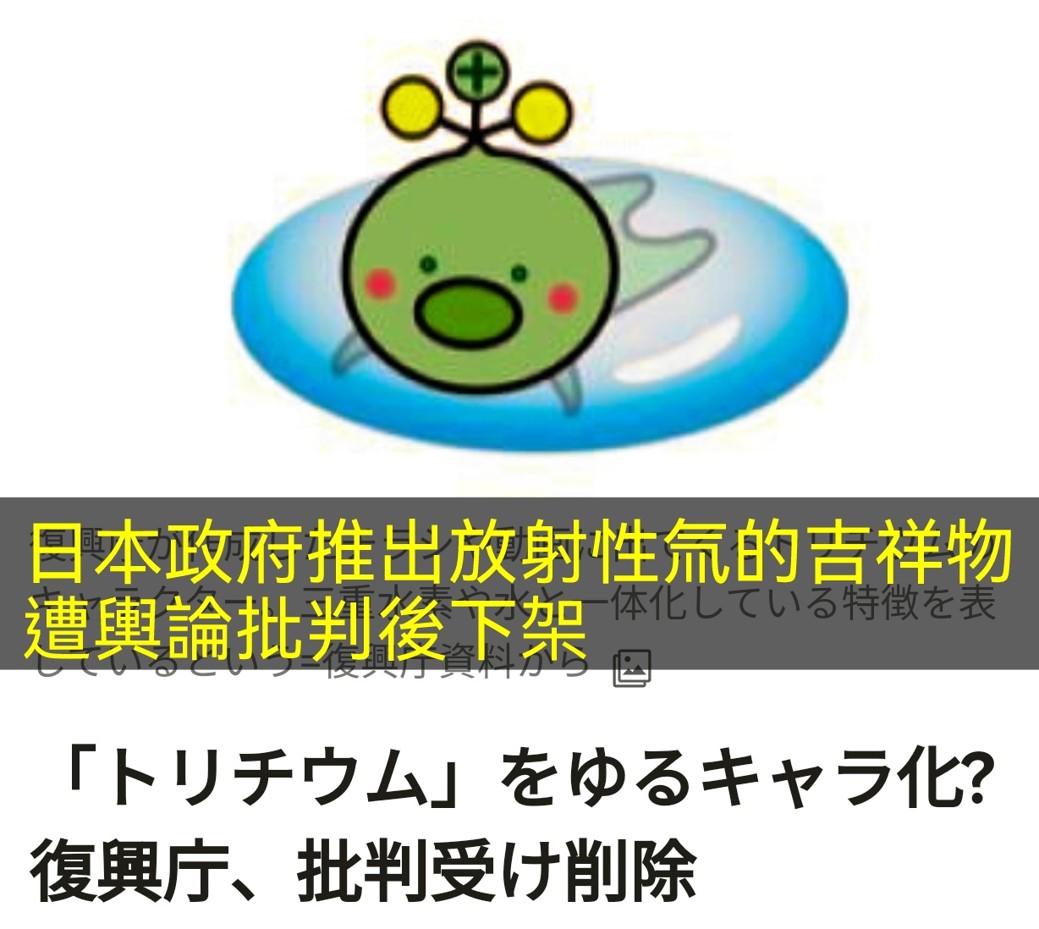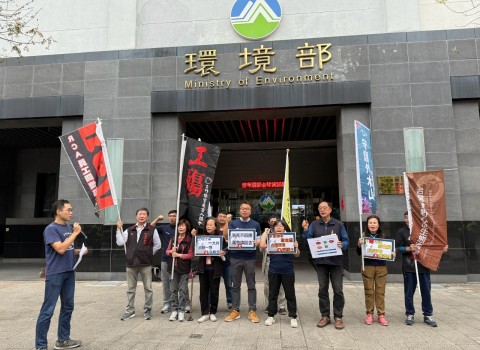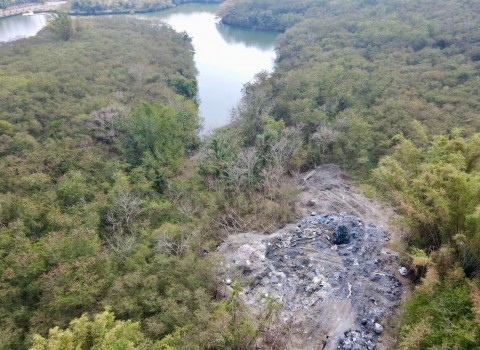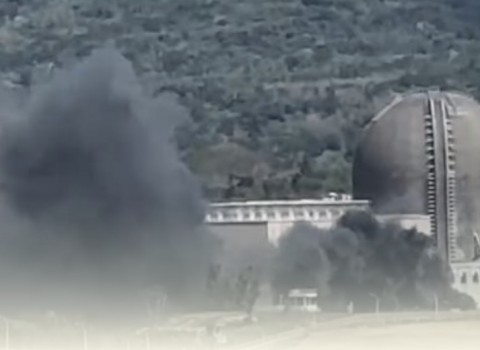*日本政府為宣傳福島輻射污染水的安全性,推出氚吉祥物,遭批評後下架。(來源:朝日新聞)
文/宋瑞文(媽媽氣候行動聯盟特約撰述)
前言:儘管國際原能總署表示,將提高福島輻射污染水放流相關數據的可靠性;然而,由全美上百家海洋實驗室組成的全美海洋實驗所聯盟NAML則基於科學立場反對。
(續前文)「除此之外,輻射污染水過濾裝置(多核種除去装置,英文ADVANCED LIQUID PROCESSING SYSTEM,簡寫為ALPS)宣稱,可以近乎完全地移除汙染廢水中,超過六十種不同的放射性核種(其中有些特別容易影響生物的特定組織、腺體、器官、新陳代謝管道)的說法,仍然缺乏關鍵證據,令人十分憂慮。」
「東京電力公司及日本政府提供的佐證資料不足,某些部分還是錯誤的,並在取樣協定、統計設計、樣本分析、及假設部分有瑕疵。其中假設部分的瑕疵會導致所謂『安全』的結論有瑕疵,排除了是否有比排放入海更好選項的全面性評估。」(全美海洋實驗所聯盟NAML)
日本學者反對理由
海外學者之外,福島輻射污染水放流的問題,日本的學者當然也有批判。
2018年在東京都一場輻射污染水處理的公聽會上,前京都大學物理教授山田耕作,解釋無法過濾的氚之危險性:「佔人體大部分的一般的水的氫,與有放射性的氚,生物是會無法區別地加以攝取、結合的。並成為危害更大的有機結合型氚。」
對於氚的危害,日本政府的說法是,平常核電廠就會排放,乍聽之下,一般人容易覺得問題不大,然而山田耕作教授進一步說明:「(1975~97年間陸續運轉的)玄海核電廠附近的居民,隨著距離越近,白血病罹患比例越高。全國平均是每10萬人有5.8人,而玄海町是38.8人。」至於其他官方說法,也有專家學者提出異議。(詳見文章:原子力寄生委員會! 福島輻射污染水問題重重)
玄海核電廠的白血病關聯研究,由前大學講師暨醫學博士森永徹在2015年所做。該核電廠為日本氚排放量最多。2019年2月,日本壱岐新報報導了研究的根據、概要與相關辯證。森永徹認為,是核電廠的氚污染誘發白血病所致。
此外,福島輻射污染水即便經過處理,和一般核電廠的廢水也不一樣。
日本自民黨「處理水等政策學習會」代表、眾議會議員山本拓,在2021年受訪時表示:「ALPS處理過的輻射污染水,有11種放射性核種是一般核電廠廢水所沒有的。一般核電廠的核燃料棒,外層有包覆,冷卻水也沒有直接接觸到。而福島的輻射污染水,則是和裸露的燃料棒直接接觸而產生的。」
日本政府宣傳
儘管爭議不斷,日本政府自決定輻射污染水放流後,仍大手筆宣傳安全無虞的官方說法。例如,中央政府直接要求中小學發放相關傳單,或利用車站電子看板大幅廣告等。
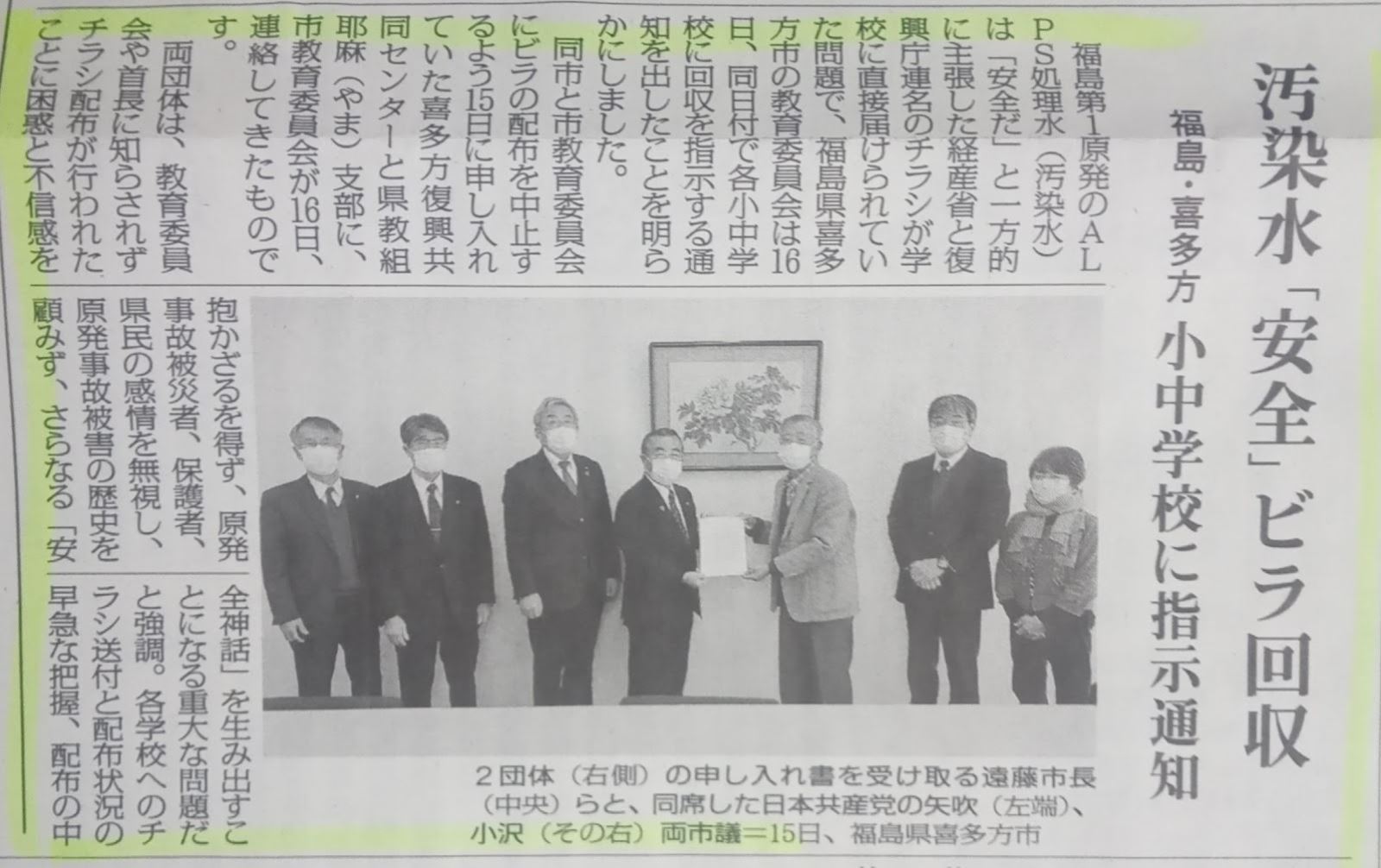
*報紙刊載,福島縣喜多方市回收輻射污染水放流安全宣傳傳單。(來源:推特)
政府宣傳引發不少爭議。例如,復興廳曾經使用代表氚的吉祥物玩偶,試圖讓民眾降低警戒,但隨即招來輿論強烈批判,下架以平眾怒。還有家長與地方政府抗議等。福島縣喜多方市因為反對放流政策,回收中央政府直接發給學校的宣傳傳單(上圖)。
日本公民記者野池元基,曾依照日本情報公開法律,索取政府文件,得知福島核災後至2021年底期間,日本各級政府花了300億日圓預算,宣傳核災污染的官方說法。據女性自身報導,前述的氚吉祥物,便是來自復興廳給廣告公司電通一筆預算3億700萬日圓的宣傳業務。(詳見文章:日本農夫揭發政府耗資300億元影響輿論 獲新聞獎項表彰)
福島輻射污染水的問題,不僅只於海洋污染與健康風險,還有國際原能總署IAEA的擁核立場,與核電廠平時氚排放水的污染等議題。由於前述學者、專家,與學術機構的說明與努力,一般民眾才得以在官方說法之外,得到交互辯證的資訊。
*附錄:全美海洋實驗所聯盟NAML反對福島輻射污染水立場書放流全文(附中譯)來源網址
National Association of Marine Laboratories
國家海洋實驗室聯盟
Position Paper
立場書
翻譯/李一帆(台中科技大學英語講師)
Scientific opposition to Japan’s planned release of over 1.3 million tons of
radioactively contaminated water from the Fukushima-Daiichi Nuclear
Power Plant disaster into the Pacific Ocean. -December 2022
基於科學立場反對日本排放來自福島第一核電廠事故的超過一百三十萬噸放射性廢水進入太平洋。2022年十二月
The National Association of Marine Laboratories (NAML), an organization of more than 100 member laboratories, opposes Japan’s plans to begin releasing over 1.3 million tons of radioactively contaminated water from the Fukushima-Daiichi Nuclear Power Plant into the Pacific Ocean commencing in 2023. This opposition is based on the fact that there is a lack of adequate and accurate scientific data supporting Japan’s assertion of safety. Furthermore, there is an abundance of data demonstrating serious concerns about releasing radioactively contaminated water.
國家海洋實驗室聯盟(NAML)是一個有超過一百個成員實驗室的組織。我們反對日本在2023年計畫開始排放福島第一核電廠事故產生的超過一百三十萬噸放射性汙染廢水進入太平洋。此反對是基於以下事實:沒有足量以及精準的科學證據支持日本宣稱的安全性。此外,有許多資料對於排放放射性汙染廢水表達嚴重擔憂。
The Pacific Ocean is the largest continuous body of water on our planet, containing the greatest biomass of organisms of ecological, economic, and cultural value, including 70 percent of the world’s fisheries. The health of all the world’s ocean ecosystems is in documented decline due to a variety of stressors, including climate change, over-exploitation of resources, and pollution.
太平洋是地球上最大的連續水體,有龐大的生物總量,具有生態上、經濟上、以及文化上的價值,包括世界上70%的漁場。紀錄顯示,由於多種壓力來源,包括氣候變遷,資源過度開發,以及汙染的緣故,全世界海洋生態系的健全程度都正在惡化之中。
The proposed release of this contaminated water is a transboundary and transgenerational issue of concern for the health of marine ecosystems and those whose lives and livelihoods depend on them. We are concerned about the absence of critical data on the radionuclide content of each tank, the Advanced Liquid Processing System, which is used to remove radionuclides, and the assumption that upon the release of the contaminated wastewater,“dilution is the solution to pollution.”
這次預計要排放的汙染廢水是一個令人憂心的跨疆域以及跨世代的事件,將會影響海洋生態系的健全以及那些生命以及生計都仰賴海洋的人們。我們十分焦慮,因為個別儲存槽之中存在的放射性核種不明,先進液體處理系統(用以去除放射性核種)的運作成謎,以及關於排放廢水的討論之中所謂「稀釋是汙染的解方」的假設缺乏關鍵資料佐證。
The underlying rationale of dilution ignores the reality of biological processes of organic binding, bioaccumulation, and bioconcentration, as well as accumulation in local seafloor sediments. Many of the radionuclides contained in the accumulated waste cooling water have half-lives ranging from decades to centuries, and their deleterious effects range from DNA damage and cellular stress to elevated cancer risks in people who eat affected marine organisms, such as clams, oysters, crabs, lobster, shrimp, and fish. Additionally, the effectiveness of the Advanced Liquid Processing System in almost completely removing the over 60 different radionuclides present in the affected wastewater—some of which have an affinity to target specific tissues, glands, organs, and metabolic pathways in living organisms, including people—remains a serious concern due to the absence of critical data.
「稀釋」的說法背後的基本原理忽略了生物學上的有機連結、生物累積、生物濃縮,以及當地海床沉積物的累積過程。在囤積的廢冷卻水中含有的放射性核種,半衰期長達數十年至數個世紀不等。它們對於吃下遭受汙染的水產品—包括貝類、牡蠣、螃蟹、龍蝦、蝦、魚—的民眾會導致從DNA損害、細胞層級壓力、到致癌風險等有害效果。除此之外,先進液體處理系統宣稱可以近乎完全移除受汙染廢水中超過六十種不同的放射性核種—其中有些特別容易影響生物(包括人類)的特定組織、腺體、器官、以及新陳代謝管道—的說法仍然缺乏關鍵證據,令人感到十分憂慮。
The supporting data provided by the Tokyo Electric Power Company and the Japanese Government are insufficient and, in some cases, incorrect, with flaws in sampling protocols, statistical design, sample analyses, and assumptions, which in turn lead to flaws in the conclusion of safety and prevent a more thorough evaluation of better alternative approaches to disposal. A full range of approaches to addressing the problem of safely containing, storing, and disposing of the radioactive waste have not been adequately explored, and alternatives to ocean dumping should be examined in greater detail and with extensive scientific rigor.
東京電力公司以及日本政府提供的佐證資料不足,某些部分還是錯誤的,並且在取樣協定、統計設計、樣本分析、以及假設部分有瑕疵。其中假設部分的瑕疵會導致所謂「安全」的結論有瑕疵,排除了是否有比排放入海更好選項的全面性評估。完整的問題應對方案,包括安全存放、儲存,以及放射性廢水的處置沒有被充分探討,而且除了排放入海之外的各個選項細節應該要廣泛地科學化精準探究。
NAML calls on the Government of Japan and International Atomic Energy Agency (IAEA) scientists to more fully and adequately consider the options recommended by the Pacific Islands Forum’s Expert Panel. We believe public policy decisions, regulations, and actions must keep pace with and make use of relevant advancements in our scientific understanding of the environment and human health. In this case, we believe policy makers have not fully availed themselves of the available science and should do so before making any final decisions on releasing this contaminated water into the Pacific. NAML members are unified in our concern
about use of the oceans as a dumping ground for radioactively contaminated water and other pollutants because such actions can negatively affect the long-term health and sustainability of our planet.
國家海洋實驗室聯盟(NAML)呼籲日本政府以及國際原子能總署(IAEA)的科學家們更完整並且充分考量由太平洋島國論壇的專家小組建議的選項。我們相信公共政策的決定、規定與行動必須要跟上相關環境科學以及醫學研究進展,並採用其成果。針對此案例,我們相信決策者並沒有完全利用現有科學資源,而且應在最後決定排放汙染廢水進入太平洋之前採納科學意見。NAML成員對於將海洋作為放射性汙染廢水以及其他汙染物的傾倒場所一致表達擔憂。此種行為會對我們的星球的長期健康以及永續性造成負面影響。
We urge the Government of Japan to stop pursuing their planned and precedent-setting release of the radioactively contaminated water into the Pacific Ocean and to work with the broader scientific community to pursue other approaches that protect ocean life; human health; and those communities who depend on ecologically, economically, and culturally valuable marine resources.
我們督促日本政府停止進行開啟不良先例的,將放射性廢水排放入太平洋的計畫,並且與廣大科學社群合作,尋求其他處理方式來保護海洋生命、人類健康、以及那些在生態、經濟、文化方面仰賴珍貴海洋資源的社群。
Adopted by the NAML Board of Directors, December 12, 2022.
由NAML董事會採納通過,2022年十二月十二日。
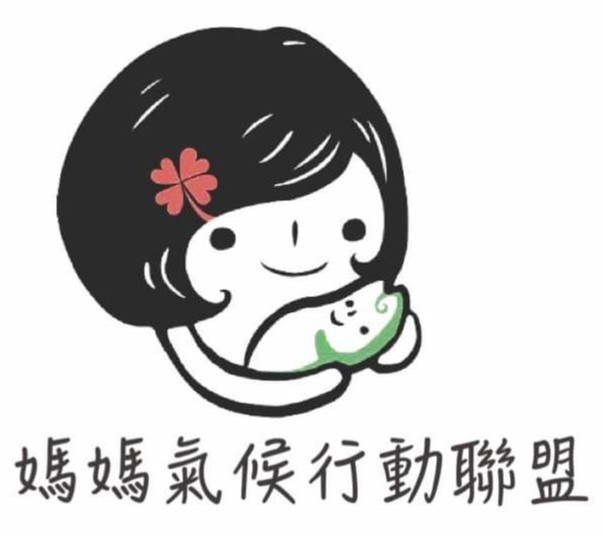
※本文由媽媽氣候行動聯盟獨家授權公民行動影音資料庫轉載。

